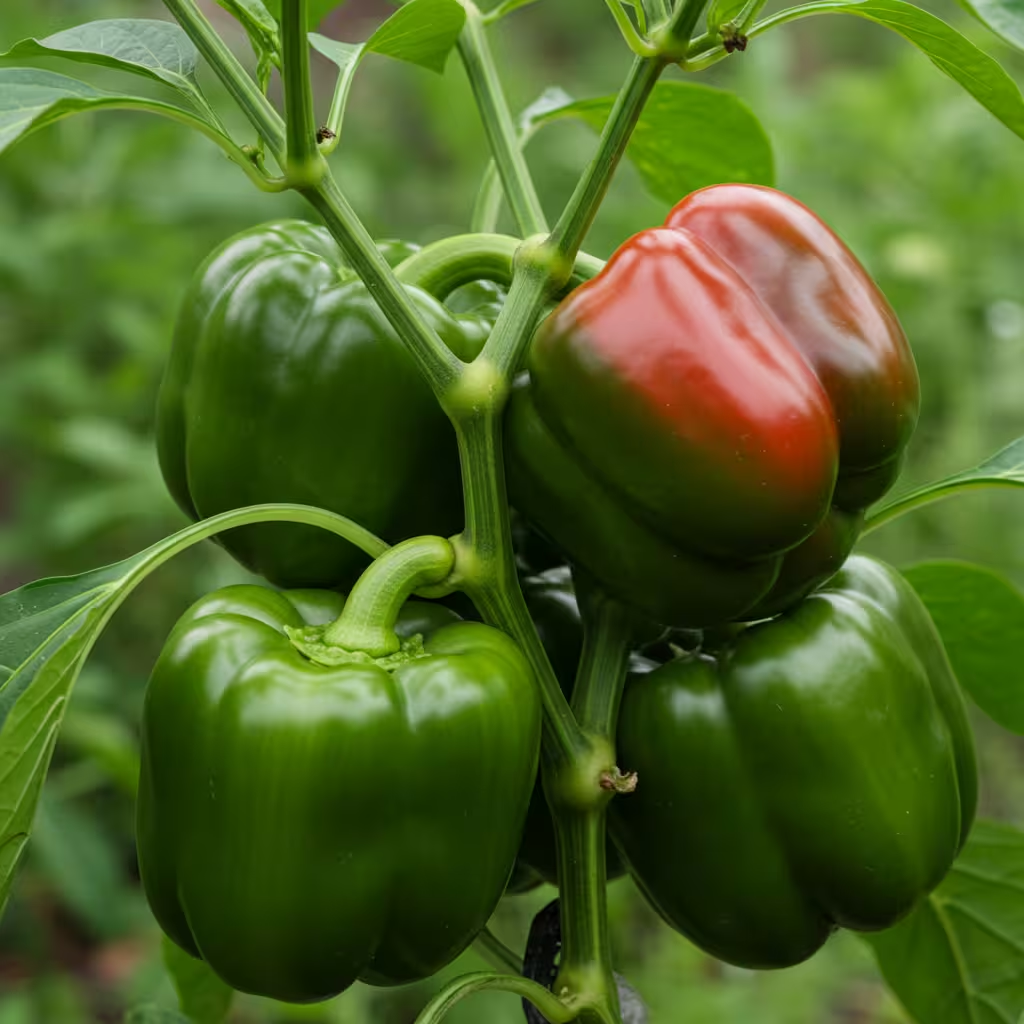Growing abundant, healthy peppers at home requires more than just good soil and adequate sunlight. While most gardeners focus on these basics, they often overlook a critical element that can dramatically impact their harvest: properly fertilizing pepper seedlings during their earliest growth stages.
This guide reveals a powerful but little-known fertilizing technique that can transform your pepper plants from average producers to garden superstars. By implementing this simple, natural feeding method at precisely the right time, you can potentially double your pepper yield while producing stronger, more disease-resistant plants.
Why Early Fertilization Makes or Breaks Your Pepper Harvest
Pepper plants (Capsicum species) establish their productive potential during the first 4-6 weeks of life. During this critical window, these nutrient-demanding seedlings develop the foundation for their entire growing season:
- Root architecture: The size, depth, and branching pattern of the root system
- Stem strength: The thickness and cellular structure of the main stem
- Growth hormone balance: The internal chemical signals that determine branching and fruiting patterns
- Early flower bud initiation: The microscopic beginnings of future fruit production
When pepper seedlings receive inadequate nutrition during this formative stage, they often develop permanent limitations that no amount of later care can fully correct. Even if they survive and eventually produce peppers, their yield will be significantly reduced compared to their genetic potential.
The Surprising Nutritional Needs of Young Pepper Plants
Unlike some vegetables that thrive on nitrogen-heavy feeding, pepper seedlings require a more sophisticated nutritional approach:
- Balanced macronutrients: Equal or near-equal ratios of nitrogen, phosphorus, and potassium
- Critical micronutrients: Particularly calcium, magnesium, and iron
- Biological stimulants: Compounds that activate specific metabolic pathways
- Beneficial microorganisms: Soil life that supports nutrient uptake and plant immunity
Most commercial seed-starting mixes contain minimal nutrients, designed only to support the first 2-3 weeks of growth. Once seedlings develop their first true leaves, they quickly deplete these limited resources, entering a state of “hidden hunger” where deficiencies begin to impact development before visible symptoms appear.
The Power-Packed Natural Fertilizer Formula for Pepper Seedlings
This specialized homemade fertilizer provides exactly what young pepper plants need during their critical development phase. Best of all, it uses simple, affordable ingredients that most households already have or can easily obtain.
Ingredients and Their Plant-Boosting Benefits
What You’ll Need:
- 1 liter (about 4 cups) of warm water
- 1 teaspoon of regular white or raw sugar
- 1 teaspoon of active dry baking yeast
- 10 drops of iodine solution (5% pharmaceutical grade)
The Science Behind Each Component:
1. Sugar: Acts as both food for beneficial soil microbes and an immediate energy source for plants. Research has shown that small amounts of sugar can:
- Stimulate beneficial bacterial and fungal activity in the soil
- Provide readily available carbon for energy metabolism
- Support mycorrhizal fungi development that enhances nutrient uptake
2. Active Dry Yeast: A powerhouse of growth-promoting compounds including:
- B-complex vitamins that function as enzyme cofactors in plants
- Natural growth hormones including auxins and cytokinins
- Amino acids that plants can directly absorb and utilize
- Enzymes that help break down organic matter into plant-available nutrients
3. Iodine Solution: Provides multiple benefits beyond its well-known antimicrobial properties:
- Enhances chlorophyll formation for better photosynthesis
- Acts as a protective agent against certain fungal pathogens
- Functions as a trace mineral nutrient that supports overall plant health
- Improves water and nutrient absorption capacity
4. Warm Water: Serves as more than just a carrier for the other ingredients:
- The temperature (around 100-110°F/38-43°C) activates yeast without killing beneficial organisms
- Helps dissolve elements for better availability to plant roots
- Ensures even distribution of all components
Preparation Method: Activating the Biological Power
Step 1: In a clean container, combine the warm water and sugar, stirring until the sugar completely dissolves.
Step 2: Add the dry yeast and stir gently to incorporate without creating excessive foam.
Step 3: Place the mixture in a warm location (70-80°F/21-27°C) for 2-3 hours. This incubation period allows the yeast to activate and multiply, increasing the solution’s biological activity.
Step 4: Once the mixture shows signs of fermentation (slight foaming or bubbling), add 10 drops of iodine solution and stir gently to combine.
Step 5: Use the solution immediately for best results, as its biological activity begins to diminish after 24 hours.
The Perfect Timing and Application Method
Applying this specialized fertilizer at the right time and in the correct manner maximizes its effectiveness while preventing potential issues like burning or promoting weak, leggy growth.
When to Start Fertilizing
The optimal window for first application begins when seedlings have developed 2-3 sets of true leaves (not counting the initial seed leaves or cotyledons). This typically occurs:
- 3-4 weeks after seed germination
- When seedlings are approximately 2-3 inches (5-7.5 cm) tall
- After the stems have begun to strengthen but before they start to elongate rapidly
Beginning too early can overwhelm tender root systems, while waiting too long misses the critical developmental window.
Application Technique for Maximum Benefit
Recommended Method:
- Water seedlings with plain water 24 hours before applying the fertilizer solution
- Ensure the growing medium is slightly moist but not saturated
- Apply approximately 1-2 tablespoons of solution per seedling using a small watering can with a narrow spout or a plastic syringe (without needle)
- Direct the solution to the base of each plant, avoiding contact with leaves
- Allow the growing medium to dry slightly between applications
Application Schedule:
- First application: When 2-3 sets of true leaves have developed
- Subsequent applications: Every 12-14 days until transplanting
- Final application: 3-5 days before transplanting outdoors or into larger containers
This regime provides consistent nutrition without creating dependency or disrupting the plant’s natural growth cycles.
Visual Indicators of Success: What to Look For
After implementing this fertilization technique, you should begin noticing positive changes in your pepper seedlings within 7-10 days. Watch for these encouraging signs:
Positive Development Markers
Leaf Color and Texture:
- Rich, deep green coloration (rather than pale or yellowish)
- Slightly thicker leaf structure with a subtle glossy appearance
- Uniform color across all leaves, including older growth
Stem Development:
- Noticeably thicker stem diameter, especially at the base
- Shorter internodal spacing (distance between leaf sets)
- Development of a slight purple or reddish tint at the stem base (a healthy stress response indicating strong cellular development)
Root System:
- White, vigorous roots visible at drainage holes
- Resistance when gently tugged (indicating strong root establishment)
- Healthy white to off-white coloration without brown or slimy areas
Overall Growth Pattern:
- Compact, bushier growth rather than stretched or leggy
- Balanced development with proportional leaf size
- Early signs of lateral branch development from leaf axils
Complementary Care for Maximum Results
To maximize the benefits of this special fertilization technique, implement these complementary growing practices:
Light Management
Pepper seedlings require robust light to process the additional nutrients effectively:
- Provide 14-16 hours of direct light daily
- Position grow lights 2-3 inches above seedling tops
- If using natural sunlight, ensure 6+ hours of direct exposure
- Rotate plants regularly for even development
Temperature Control
Maintain optimal temperatures for nutrient uptake and metabolic function:
- Daytime: 70-80°F (21-27°C)
- Nighttime: No lower than 65°F (18°C)
- Avoid cold drafts that can shock plants and inhibit nutrient absorption
- Consider a seedling heat mat if growing in cooler environments
Air Circulation
Proper airflow strengthens stems and reduces disease risk:
- Use a small oscillating fan on low setting near (but not directly on) seedlings
- Run the fan for several hours daily to create gentle movement
- Ensure adequate spacing between plants as they grow
- Avoid enclosed environments without air exchange
Container Management
As seedlings respond to improved nutrition, they may require adjustments:
- Transplant to larger containers when roots begin circling the current container
- Choose containers at least 3-4 inches deep to accommodate expanding root systems
- Consider air-pruning pots that encourage stronger root development
- Ensure all containers have adequate drainage
Common Questions About This Fertilizing Method
Gardeners often have questions when implementing this technique for the first time. Here are answers to the most frequent concerns:
Can I use this fertilizer on other seedlings besides peppers?
Yes, this formula works well for most fruiting vegetables, particularly those in the Solanaceae family (tomatoes, eggplants) and cucurbits (cucumbers, squash). For leafy greens or herbs, dilute the solution by adding an additional cup of water to the mixture.
What if I don’t have iodine solution available?
While iodine provides important benefits, the yeast-sugar solution alone still offers significant advantages. In place of iodine, you can substitute 1/4 teaspoon of dissolved sea salt (not table salt) or a crushed aspirin tablet (which provides salicylic acid, a natural plant immune booster).
Can I make larger batches to store for future use?
The biological activity of this solution diminishes within 24-48 hours. For best results, prepare fresh batches each time. If you must make larger quantities, store refrigerated for no more than 3 days, and bring to room temperature before application.
Will this make my peppers spicier?
For hot pepper varieties, proper nutrition actually can increase capsaicin production (the compound responsible for heat). The improved plant health and stress resistance provided by this fertilizer often results in peppers with more concentrated flavors and heat levels true to their genetic potential.
From Seedling to Harvest: The Long-Term Impact
The benefits of this early fertilization strategy extend far beyond the seedling stage, influencing your pepper plants’ performance throughout their entire life cycle.
Mid-Season Advantages
Plants that receive optimal early nutrition typically demonstrate:
- Earlier flowering by 7-14 days compared to conventionally raised seedlings
- More flower clusters per plant (often 30-50% more flowering points)
- Better flower retention during environmental stress periods
- Improved pollination rates due to larger, more viable flowers
- Greater resistance to common pepper problems like blossom end rot
Harvest-Stage Benefits
The cumulative effect of proper early care becomes most apparent during the productive phase:
- More consistent fruit set throughout the growing season
- Larger average fruit size while maintaining variety characteristics
- Thicker fruit walls with better texture and flavor development
- Extended harvest period before plant exhaustion
- Greater tolerance for temperature fluctuations and other stresses
The Doubling Effect
The claim that this method can “double your harvest” is based on the compound effect of several improvements:
- More flowering points per plant
- Higher percentage of flowers developing into fruit
- Lower fruit drop during development
- Larger average fruit size
- Extended productive period before decline
While results vary depending on variety and growing conditions, many gardeners report harvest increases of 70-120% compared to conventionally raised pepper seedlings.
Conclusion: A Small Investment for Exceptional Returns
The specialized fertilization technique outlined in this guide represents one of the highest-return investments you can make in your pepper garden. For just minutes of preparation time and pennies worth of ingredients, you can dramatically improve your harvest potential.
Remember these key points:
- Early nutrition sets the foundation for your entire pepper harvest
- This simple yeast-sugar-iodine solution provides specialized nutrition precisely when seedlings need it most
- Proper application timing and technique maximize benefits while preventing problems
- Combined with good light, temperature management, and appropriate containers, this method can transform your pepper growing success
By giving your pepper seedlings this specialized early care, you’re not just growing plants—you’re unlocking their full genetic potential for an abundant, flavorful harvest that may well be twice what you’ve experienced before.

